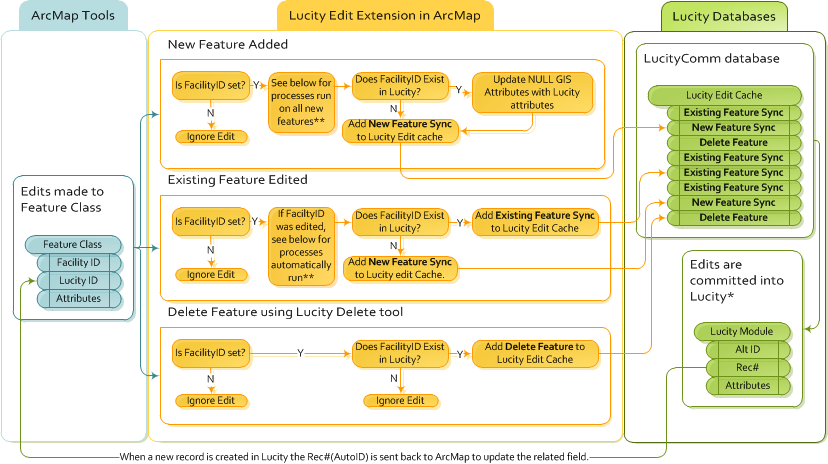
The Lucity Editing extension is designed to update Lucity with any edits made or new features added to related feature classes. It automatically starts when an Edit Session is started in ArcMap and runs in the background. It automatically tracks new features, and attribute changes. When the ArcMap edit session is saved the changes that the extension has tracked are synced into the Lucity Databases and become permanent. There are situations where it is required that uses use Lucity provided tools to make edits. These situations have to do with Alt ID fields being changed, features being deleted, etc...
Rules for Editing
Even with a custom geodatabase integration, there are still some standard business rules that must be followed to meet Lucity requirements. The extension must follow the same rules that Lucity follows when adding and editing records. It is not required for all data in the geodatabase to follow these rules; Lucity places no restrictions on data in the geodatabase. However, only those features that meet the requirements will propagate to the Lucity databases and will be accessible in the desktop inventory modules.
Editing Process
Startup
During Editing
During Editing the Editor extension follows these rules for general attribute edits, new features, and deleted features:
Types of Syncs |
|
New Feature Sync |
The New GIS feature's attributes are all pushed into the Lucity Database. This includes any fields that were automatically updated in the GIS when the editor extension checked to see if this new feature would be linked to an existing feature in Lucity. The Rec# in Lucity is sent back to update the LucityID field for the feature. |
Existing Feature Sync |
The GIS feature's attributes are all pushed into the Lucity Database. They overwrite all linked fields for the related feature. (NULL fields in the GIS do NOT overwrite non-Null fields in Lucity). |
Delete Feature |
The feature is deleted out of Lucity as it has already been deleted out of ArcMap. |

* This step occurs when the ArcMap Edit Session is saved.
**When a Facility ID is set (for a new feature) or changed (for an existing feature) the following processes are automatically run.
Important Field Names
There are several fields that are important to the Lucity sync process. Sometimes these fields are referred to using different names depending on what is being discussed, and an agency's naming schema.
Alt ID (Found in Lucity) |
This is the primary user-defined ID field for most modules within Lucity. It is a required text field that must provide each record with a unique identifier. Also called: Alt ID, Common ID, Common Link, Asset Number |
Facility ID (Found in Geodatabase) |
This is the primary user defined ID field for feature classes, and is the Esri equivalent to Lucity's Alt ID. The Facility ID is used in the Esri Local Government Information Model schema, and in the Lucity GIS Data Schema. Also called: Whatever the Agency named the field in their custom geodatabase. |
Rec # (Found in Lucity) |
This is the database-assigned ID for every record stored within the Lucity Database. It is automatically generated when the user creates a new record in Lucity and cannot be changed. Also called: Lucity Auto ID |
Lucity ID (found in Geodatabase) |
This is a field in the geodatabase that stores the Rec # for each feature in Lucity. If this field is configured with Lucity it is automatically populated in the geodatabase when a feature is created and synced to Lucity. Also called: LucityLink, gbaMSLink, Lucity Auto ID |
Special Situations
General Editing
Address/Parcel
Facility
Park
Transportation Modules
Trees